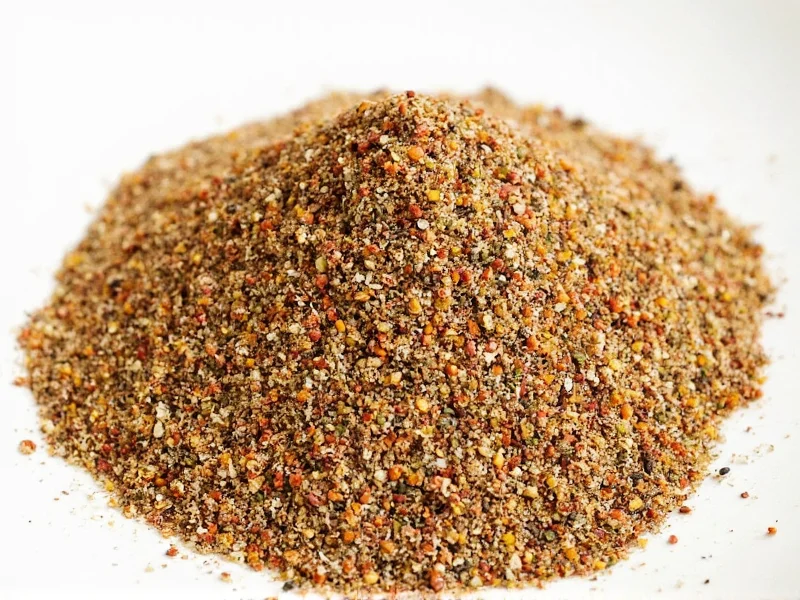Greek seasoning embodies the essence of Mediterranean cuisine through its carefully balanced herb composition. Unlike generic "Mediterranean" blends that might include rosemary or sage, authentic Greek seasoning focuses on herbs native to Greece's rocky terrain and sunny climate. The foundation of any quality blend starts with premium dried oregano—specifically Origanum vulgare subsp. hirtum, the Greek mountain variety known for its robust, slightly peppery flavor that distinguishes it from milder Turkish or Mexican oregano.
Core Components of Traditional Greek Seasoning
While family recipes vary across Greek regions, professional chefs and culinary historians recognize these essential elements in authentic blends:
| Ingredient | Typical Percentage | Flavor Contribution | Traditional Source Region |
|---|---|---|---|
| Dried Greek oregano | 40-50% | Earthy, slightly peppery with floral notes | Mainland Greece, especially Mount Olympus area |
| Garlic powder | 15-20% | Pungent, savory depth | Island of Kythira |
| Dried dill | 10-15% | Grassy, anise-like freshness | Thessaly region |
| Marjoram | 8-12% | Sweet, citrusy warmth | Crete |
| Thyme | 5-10% | Woody, lemony complexity | Santorini |
| Onion powder | 5-8% | Sweet umami foundation | Epirus region |
The precise balance creates what Greek chefs call "the holy trinity of flavor": earthiness from oregano, pungency from garlic, and brightness from dill. Unlike Italian seasoning which emphasizes basil and rosemary, Greek blends showcase oregano's starring role—a reflection of how ancient Greeks considered it the "joy of the mountain" (oros ganos in Greek).
Variations Across Greek Regions
Regional differences in what is in Greek seasoning reveal Greece's diverse culinary landscape:
- Mainland Greece: Features more robust oregano with added mint (2-3%) for lamb dishes
- Aegean Islands: Incorporates dried lemon zest (5%) reflecting citrus groves
- Crete: Includes wild thyme and slightly more marjoram
- Commercial blends: Often add salt (25-30%) and black pepper (5-10%) for broader appeal
When examining what ingredients are in Greek seasoning from different sources, note that authentic Greek blends never contain paprika, cumin, or chili powder—those indicate Middle Eastern or Americanized interpretations. The European Union's Protected Designation of Origin (PDO) requires Greek oregano to contain at least 40% oregano from specific Greek regions to carry "Greek seasoning" labeling.
Distinguishing Greek Seasoning from Similar Blends
Many home cooks confuse Greek seasoning with related Mediterranean blends. Understanding what's typically in Greek seasoning versus others prevents recipe mishaps:
- Greek vs. Mediterranean: Mediterranean blends often include rosemary and bay leaf, while Greek focuses on oregano-dill-garlic triad
- Greek vs. Italian: Italian seasoning features basil and rosemary prominently; Greek uses minimal basil (only 1-2% in coastal versions)
- Greek vs. Za'atar: Za'atar is Middle Eastern with sumac and sesame seeds—completely different flavor profile
A simple test for what makes Greek seasoning unique: authentic blends should smell predominantly of oregano with supporting garlic notes, not citrus (lemon pepper) or smokiness (paprika). The texture should be fine but not powdery—coarsely ground herbs indicate higher quality.
Practical Applications in Cooking
Knowing what's in Greek seasoning mix helps optimize its use. The herb composition makes it ideal for:
- Marinades: Combine 2 tbsp Greek seasoning with ¼ cup olive oil and lemon juice for chicken or lamb (the oregano's phenols help tenderize)
- Dry rubs: Apply directly to vegetables before roasting (the dill prevents bitterness in eggplant)
- Dips: Mix with Greek yogurt for tzatziki (authentic versions use fresh dill, but dried works in pinch)
- Sauces: Add 1 tsp to tomato sauces for moussaka (marjoram complements béchamel)
Chefs note that the what's included in Greek seasoning determines cooking timing: add early for marinades (to infuse), but late for roasted vegetables (to preserve volatile oils). Never cook Greek seasoning longer than 10 minutes to maintain its delicate flavor balance.
Creating Authentic Homemade Greek Seasoning
When commercial blends don't reveal what's actually in Greek seasoning, making your own ensures authenticity. This chef-recommended ratio captures traditional flavors:
- ¼ cup dried Greek oregano (crumbled between fingers)
- 2 tbsp garlic powder
- 1½ tbsp dried dill
- 1 tbsp marjoram
- 2 tsp dried thyme
- 1 tsp onion powder
Mix thoroughly in a glass jar, then store in a cool, dark place for 2 weeks before use—this "marrying" period allows flavors to harmonize. For regional variations, add ½ tsp dried lemon zest (island style) or 1 tsp mint (mainland style). Properly stored, homemade Greek seasoning maintains peak flavor for 6-8 months.
Quality Considerations When Purchasing
When evaluating commercial blends and questioning what's really in Greek seasoning, check for these markers of authenticity:
- Oregano listed first in ingredients (should be 40%+ of blend)
- No added salt in traditional versions (check "no salt added" labels)
- Deep green color (brown indicates old or low-quality herbs)
- Strong oregano aroma when jar is opened
- PDO certification for Greek oregano content
Avoid blends where "spice blend" or "natural flavors" appear in ingredients—these obscure the actual what's contained in Greek seasoning. Premium brands specify oregano variety (Origanum vulgare hirtum) and harvest season (summer-picked has highest essential oil content).











 浙公网安备
33010002000092号
浙公网安备
33010002000092号 浙B2-20120091-4
浙B2-20120091-4